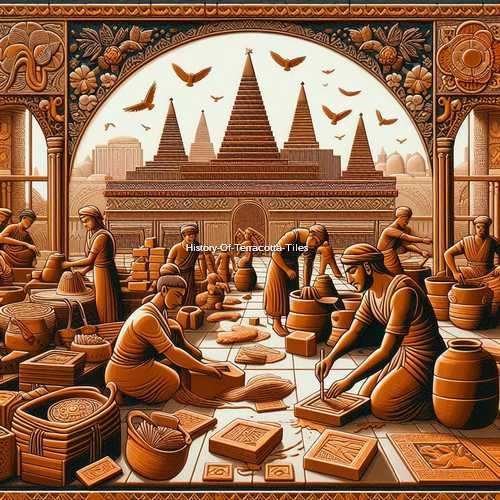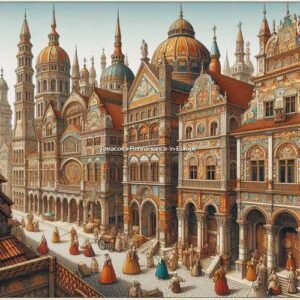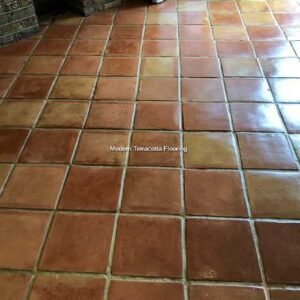


24 July 2024 by
sitemanager
Terracotta tiles have been an integral part of architecture and design for centuries, with a rich history that spans different cultures and time periods. These versatile tiles have stood the test of time and evolved in style, making them a popular choice for various applications. In this blog post, we will explore the captivating history of terracotta and delve into their common uses in contemporary design.
Terracotta, which translates to “baked earth” in Italian, has been used as a building material since ancient times. The roots of terracotta trace back to the 3rd millennium BC in Mesopotamia, where they were used in constructing dwellings and temples. The durability and natural beauty of these tiles made them ideal for such purposes.
In ancient Mesopotamia, terracotta was not just functional it was symbolic. The Assyrians and Babylonians used terracotta for both structural and decorative purposes, building palaces and religious sites, showcasing its aesthetic and cultural significance.
The early use of terracotta in Mesopotamia laid the groundwork for its enduring legacy. Mesopotamian builders recognized the material’s ability to withstand extreme weather conditions. The process of creating terracotta involved shaping clay into desired forms and then firing it at high temperatures to achieve a hardened, durable product. This technique has remained relatively unchanged for thousands of years.
The use of terracotta spread to the Mediterranean cultures of Greece and Rome, where they gained popularity due to their practicality and aesthetic appeal. In ancient Greece, terracotta was commonly used in temples and public buildings. Greek architects perfected the use of terracotta, producing tiles uniform in shape and capable of being arranged in complex patterns.
The Romans advanced terracotta tile production techniques by introducing moulds for uniformity and experimenting with shapes and designs, including intricate patterns and pictorial motifs. Roman builders utilized terracotta extensively in construction projects, from sprawling villas to public baths and amphitheatres. The development of interlocking roof tiles, known as “tegulae” and “imbrices,” was a notable Roman innovation.
Terracotta tiles in Roman architecture often depicted scenes from mythology and daily life, reflecting the cultural values and artistic achievements of the time. The durability of terracotta has ensured that many structures have survived, allowing modern observers to appreciate the craftsmanship of ancient builders.
 Terracotta Renaissance in Europe: Reviving an Ancient Craft
Terracotta Renaissance in Europe: Reviving an Ancient CraftDuring the Renaissance era in Europe, terracotta experienced a resurgence. Architects and designers turned to this versatile material to add elegance to their projects. The tiles adorned the facades of grand buildings, churches, and palaces, showcasing their ability to enhance aesthetics while providing insulation and protection.
Renaissance architects like Brunelleschi and Michelangelo incorporated terracotta into their designs, recognizing its potential for ornate, visually stunning exteriors.
The Renaissance was a period of significant technological and artistic advancements. Craftsmen developed new glazing techniques that added vibrant colors and a glossy finish to terracotta tiles, further enhancing their appeal.
The widespread use of terracotta during the Renaissance had a profound impact on European architecture, continuing into the Baroque and Rococo periods.
Today, terracotta continues to be popular in contemporary design. Their natural earthy tones and rustic charm lend warmth and character to indoor and outdoor spaces alike. In modern interior design, terracotta floors create a cosy and inviting atmosphere, often used in kitchens, living rooms, and bathrooms.
Terracotta floors are an eco-friendly option for sustainable building practices. Made from natural clay, they are biodegradable and have a low environmental impact. Their production process requires less energy compared to other building materials, and their durability means they have a long lifespan, reducing the need for frequent replacements.
Recent design trends have seen a resurgence in the use of terracotta, with designers and architects exploring new ways to incorporate this timeless material into their projects. From geometric patterns and bold colours to minimalist and industrial aesthetics, terracotta tiles are being reimagined to suit contemporary tastes.
 Common Uses and Applications: Versatile and Functional Terracotta Tiles
Common Uses and Applications: Versatile and Functional Terracotta TilesTerracotta adds a timeless appeal to floors, both indoors and outdoors. Furthermore, their warm hues create a cosy and inviting ambiance. Additionally, the natural variations in colour and texture give each tile a unique character.
Terracotta can create stunning feature walls, adding texture and visual interest to any room. They work exceptionally well in spaces aiming for a rustic or Mediterranean-inspired aesthetic.
The durability of terracotta makes it an excellent choice for roofing. They provide protection against the elements while imparting distinctive charm to any structure.
Terracotta tiles can be used as decorative accents in various architectural elements, such as arches, columns, and cornices. Their versatility allows designers to create unique and visually appealing details.
Terracotta tiles can be incorporated into garden paths, courtyards, and poolside areas, adding natural beauty to outdoor spaces. Their earthy tones and textured surfaces blend seamlessly with the natural environment.
Terracotta tiles are eco-friendly, made from natural clay, and have a low environmental impact. Their durability and long lifespan reduce the need for frequent replacements.
Regular cleaning and proper sealing can enhance the color. Using a color-enhancing sealer can also bring out the natural hues.
Yes, modern trends include geometric patterns, bold colors, and integration into minimalist and industrial aesthetics.
Proper surface preparation, using the right adhesive, and allowing sufficient drying time are essential. Professional installation ensures secure placement.
Yes, terracotta tiles are compatible with heated flooring systems, providing efficient heat distribution and maintaining a comfortable temperature.